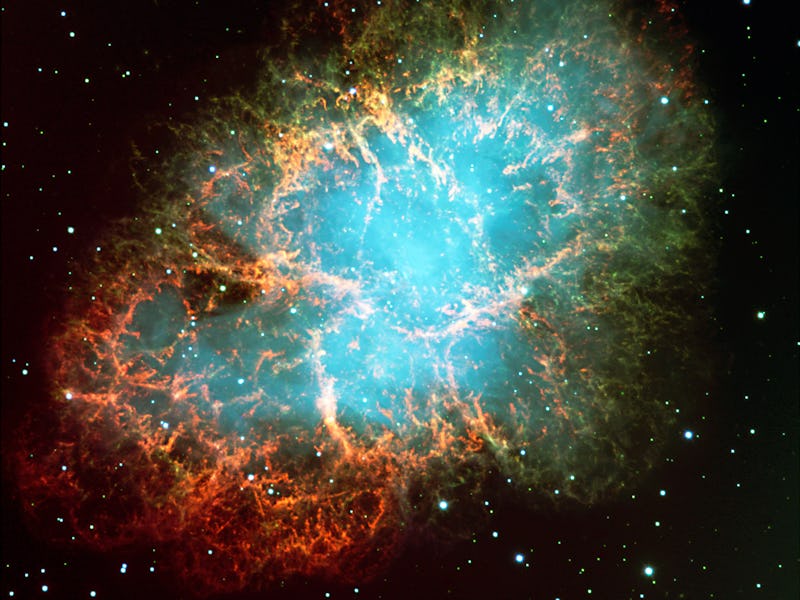The crushed cores of dead stars hold clues to mysterious radio signals
NASA's NICER telescope detected giant radio pulses from the Crab Nebula and found more powerful energy signals than ever anticipated.

The universe is always humming with energy — we just have to know where and how to look. And a well-studied object has been hiding a powerful, noisy secret from us.
Using a telescope mounted on the International Space Station (ISS), a team of astronomers has detected giant radio pulses from the neutron star in the heart of the Crab Nebula. They discovered it to be tens to hundreds of times more energetic than previously believed.
Although the source of these giant radio pulses remains unknown, scientists now believe that these emissions span across the electromagnetic spectrum from radio waves to X-rays, deepening their mystery.
The recent findings are detailed in a study published April 9 in the journal Science, and could unlock the mystery behind fast radio bursts — enigmatic radio signals coming from deep space.
WHAT’S NEW — From August 2017 to August 2019, Teruaki Enoto, a researcher at the RIKEN Cluster for Pioneering Research in Japan and lead author of the new study, took an intensive look at the pulsar in the Crab Nebula.
A pulsar is sort of like a zombie star. They are fast-rotating neutron stars, which are the super-dense remains of a massive star that exploded in a supernova. These stars emit electromagnetic radiation in the form of bright, narrow radio beams that sweep across the cosmos in a round motion as the star itself spins.
They take their name from their metronome-like radio pulses. Pulsars typically emit radio waves, though some also are detectable in visible light, X-rays, and gamma rays.
While most pulsars emit beams, those like the Crab Pulsar have additional powerful events called giant radio pulses. They are short-lived, millisecond pulses of radio waves that occur sporadically. The new study found that their sheer intensity was 10s to 100s of times more powerful than we’ve ever believed.
“Out of more than 2,800 pulsars cataloged, the Crab pulsar is one of only a few that emit giant radio pulses,” Enoto tells Inverse.
How they did it — Using NASA’s Neutron star Interior Composition Explorer (NICER) telescope on the ISS, the team investigated mysterious radio pulses coming from within the nebula.
They followed up those observations via two ground-based radio telescopes in Japan, the 34-meter dish at the Kashima Space Technology Center and the 64-meter dish at the Japan Aerospace Exploration Agency’s Usuda Deep Space Center.
Enoto and his team gathered the largest amount of simultaneous X-ray and radio data ever collected from a pulsar.
The data also suggests that giant radio pulses are produced by underlying processes that lead to emissions spanning across the electromagnetic spectrum, which includes all types of radiation, starting from low energy radio waves to deadly radioactive gamma rays. Subsequently, astronomers look in a variety of spectra to determine what is happening beyond our visible range.
HERE’S THE BACKGROUND — The Crab Nebula is located 6,500 light-years away in the constellation Taurus. It formed from the aftermath of a supernova whose light reached Earth in July 1054 CE.
The pulsar sits at the center of the nebula and spins 30 times a second.
Enoto’s team was able to capture activity across 3.7 million pulsar rotations, producing around 26,000 giant radio pulses in that time. However, scientists are still not sure how pulsars are able to produce these giant wide-ranging emissions.
Data taken by the NICER telescope on the ISS from the Crab Pulsar found more energetic signals than astronomers ever believed.
WHY IT MATTERS — Scientists believe that these high-energy emissions from pulsar stars could unlock the mystery behind fast radio bursts.
Fast radio bursts were first detected in 2007 as strange blasts of radio waves that last for just a few milliseconds while releasing more energy than the Sun does in nearly a century.
“Fast radio bursts are one of the hottest topics in astronomy and everybody wants to know the origin of fast radio bursts,” Enoto says.
For years, scientists have debated the origins of fast radio bursts, examining whether they are produced by colliding black holes, magnetars, pulsar stars, or some other unexplained event.
However, they are still not sure of their true source. But magnetars — a magnetically active kind of neutron star — are believed to be responsible for repeating fast radio burst sources.
The study found that the giant radio pulses didn’t have the “right stuff” to be fast radio bursts, ruling them out as the origin. But by studying the nebula pulses, we may be able to understand what happens in supernova remnant systems, and perhaps trace an origin for both phenomena.
Abstract: Giant radio pulses (GRPs) are sporadic bursts emitted by some pulsars that last a few microseconds and are hundreds to thousands of times brighter than regular pulses from these sources. The only GRP-associated emission outside of radio wavelengths is from the Crab Pulsar, where optical emission is enhanced by a few percentage points during GRPs. We observed the Crab Pulsar simultaneously at x-ray and radio wavelengths, finding enhancement of the x-ray emission by 3.8 ± 0.7% (a 5.4σ detection) coinciding with GRPs. This implies that the total emitted energy from GRPs is tens to hundreds of times higher than previously known. We discuss the implications for the pulsar emission mechanism and extragalactic fast radio bursts.
This article was originally published on